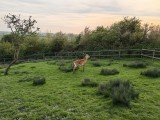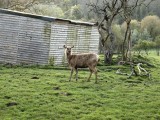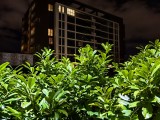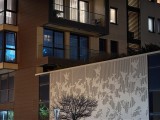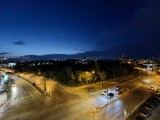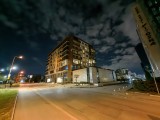Huawei P60 Pro review

Triple camera on the back, primary has variable aperture
The Huawei P60 Pro takes a lot of its camera technology from the Mate 50 Pro. The 48MP primary has a variable aperture, then comes a 48MP telephoto for 3.5x optical zoom, and finally, there is a 13MP ultrawide camera. You won't find Leica logos on the P60 Pro, only Huawei's XMAGE camera logo.

The primary camera (called Ultra Lighting Camera) uses a 48MP sensor with large 1.17µm pixels with a Quad-Bayer RYYB color filter and a stabilized (OIS) 24.5mm lens (even if EXIF reports 27mm) lens with variable f/1.4-f/4.0 aperture. The Camera app chooses the aperture automatically, but in Pro mode, you can adjust it yourself in 10 different steps.

The ultrawide has a 13MP sensor behind a 13mm f/2.2 lens. This camera supports autofocus, which allows it to capture close-ups, too.
The telephoto camera (called Ultra Lighting Telephoto Camera) also relies on a 48MP sensor (Quad-Bayer RYYB color filter) with a stabilized (3-axis OIS) 90mm (95mm per EXIF) f/2.1 periscope lens. The bright f/2.1 aperture should fare much better in night shots than competing modules from other makers. Huawei says this lens can capture the largest amount of light in the industry (for a 90mm lens), which is a pretty bold claim. It also has sensor-shift stabilization, which is rather rare. Oh, and this camera offers telemacro capabilities and can focus from as close as 15cm!
The focal length of the main and tele cameras are different as per EXIF - the reason is Huawei's practice of slightly cropping the sensor and upscaling the images back for reasons unknown.
There is a color temperature sensor at the back for improved color accuracy and a laser focusing system that assists the autofocus at shorter ranges (cleverly hidden in the black bezel around the main camera).
The front camera is advertised as 13MP, though the hardware scanning apps detect the sensor as 14.4MP with 1.22µm pixels. It sits behind an 18mm f/2.4 lens, but the focus is fixed, unfortunately.
When using the selfie camera, you choose between three zoom modes - wide-angle (18mm, no crop), 0.8x (21mm equiv. crop, but there should be no upscale) and 1x (27mm equiv. crop and upscale).
Camera app
The camera is enhanced by Huawei's AI, just as before. It recognizes and tunes settings for a ton of scenes. There's a toggle in the viewfinder for turning AI enhancements off and on, so you don't have to go into settings for that.
There's a Pro mode, too, where you can adjust parameters yourself - aperture for the main camera (f/1.4, f/1.6, f/1.8, f/2.0, f/2.2, f/2.5, f/2.8, f/3.2, f/3.5, f/4.0), ISO, shutter speed (1/4000s to 30s), exposure compensation (-4 to +4EV in 1/3 stop increments), and white balance (presets and specific light temperature). You can also choose the metering mode (matrix, center-weighted, and spot) and the focus mode (single, continuous, and manual). If the phone thinks you messed up the exposure, an icon will pop up to warn you.

The Pro mode works on ultrawide and telephoto cameras, too. RAW mode is available across all rear cameras, too.






Pro mode • Pro mode • Pro mode • Pro mode • Super Macro
By the way, Pro mode is available for video as well, and the maximum ISO there is 6,400 (3,200 for the UW and tele cams). And you can set the desired shutter speed.
Both the selfie and the primary camera interface offer zoom levels. For the back setup, you get W, 1x, 3.5x and 10x options. Meanwhile, for the front one, you get W, 0.8x and 1x. The selfie camera has a higher-than-advertised resolution sensor, so most, if not all, zoom levels should be lossless.
Daylight photo quality
The P60 Pro is Huawei's second smartphone to offer variable aperture, one that goes between f/1.4 and f/4.0. But unlike Xiaomi, Sony and Samsung, which offer two fixed positions, the P60 Pro allows for a true variable aperture offering ten steps starting from f/1.4 up to f/4.0. These should be enough for the pro users.
The variable aperture is great for the camera - this way, you can control the depth of field and the light that gets through.
For example, shooting at the largest f/1.4 aperture will give you an incredibly shallow depth of field (DoF) with excellent bokeh. Large aperture is also excellent for night shots.


You can click/tap to enlarge the photo collages above.
We have also prepared four identical shots with different apertures, and you can easily compare them with our dedicated Picture Compare Tool (the icon at the end of each row of photos). Enjoy.
The main camera saves 12MP photos by default, and the Auto mode uses f/2.0 aperture for all of them. And the samples we shot look great.
Okay, we will elaborate. All photos have an incredible amount of detail, they are sharp just right, and there is no noise whatsoever. The rendition is very pleasing and natural-looking.
The contrast and the dynamic range across the photos are great, and the colors are accurate.
Huawei is known for its mature image processing, and it's evident why on the P60 Pro photos. People, foliage, cars, flowers - everything looks natural and lacks the overprocessed look many other competitors are aiming for.
The main camera uses a smaller sensor than the 1-inchers found on the Xiaomi 13 Ultra and Find X6 Pro, but we can hardly see any areas where it was out resolved.
We've prepared some sample photos from a safari that Huawei organized for the media. Those were taken from a moving vehicle.
The main camera can offer high-quality 2x zoom; it even has it in the Portrait mode as a fixed step. The photos are less detailed than the regular ones, but the difference isn't that large. And the rest of their properties are as excellent as the default ones. Do bear in mind that those weren't taken on a sunny day as the rest of the 1x photos.
The camera app offers two high-res modes - 48MP and 48MP AI. The default 48MP option saves upscaled versions of the 12MP images of the unprocessed output of the sensor - meaning they are noisier and less contrasty if downscaled to 12MP when compared to the ones taken with the Photo Auto mode.
The 48MP AI mode, previously known as AI Ultra Clarity, stacks multiple high-res images to achieve sharper photos. Well, there is a noticeable difference, and you can clearly see there is a noticeable difference in the resolved detail and the noise reduction between the two high-res options.
Unfortunately, they are hardly impressive and downsizing them to 12MP will give you an identical photo to the one saved by the Photo (auto) mode.
The telephoto camera on the Huawei P60 Pro has 90mm f/2.1 lens - meaning it offers the largest aperture on such a long telephoto camera. The native optical zoom is 3.5x, and there is another 10x fixed shortcut on the viewfinder.
The 3.5x zoomed photos we shot on the Huawei P60 Pro are magnificent - the resolved detail is abundant, the sharpness is spot-on, and there is no noise. And the close-up shots offer pleasant bokeh, possibly thanks to the larger aperture.
The colors are consistently accurate as on the other cameras, the contrast is great, and the dynamic range is lovely yet not over the top.


















3.5x zoom telephoto camera, 12MP
And here are some more photos from the safari. Those were taken at 3.5x zoomed from a moving vehicle.
This camera can focus from as close as 10cm-15cm, which makes it ideal for macro photography - a thing usually tasked to the more premium ultrawide cameras with autofocus capabilities.
There is an Automatic Super Macro mode, but we didn't use it, as it seems to crop and upscale from the regular photo and often saves softer images.
Anyway, the telemacro samples we took are superb - the bokeh is excellent, and the subject is sharp and well-exposed. The whole photo offers a pleasant color rendition and outstanding dynamic range.
Let's look at the 10x zoomed photos now. Surprisingly, we found those to be more detailed than the 10x zoomed images taken on the Huawei Mate 50 Pro, which used a 64MP camera with a similar lens.
Obviously, those are cropped and upscaled from the large 48MP sensor, but the upscaling was done proficiently, and the images are quite nice. You can tell digital zoom was involved because of the average detail and the somewhat washed look, but they are still very much usable, especially if downsized to, say, 8MP.
So, the 10x photos are average in detail, but other than that - there is no noise, the colors are accurate, and the dynamic range is superb. So, adding a 10x zoomed shortcut was not pointless; on the contrary, the achieved magnification and quality are quite impressive given the limitation of the sensor and its lens.
The 13MP ultrawide camera supports autofocus, but unlike previous Huawei phones, we had no issues with it on the P60 Pro - it was 100% reliable and got us no blurry images.
So, the 13MP photos we shot on the P60 Pro are easily class-leading in the ultrawide-angle camera scene. First, they offer an incredibly wide field of view. And second, their quality is excellent.
All UW photos we took offer a ton of resolved detail, excellent sharpness and no noise. The corners are proficiently corrected, and they are still quite sharp, which is a great achievement. Furthermore, the UW images offer accurate colors and match the ones the other cameras.
We also liked the wide dynamic range across all photos and the natural rendition of, well, everything. Huawei does brag about its XD Fusion Pro texture engine, which shows objects that are true to life, and it surely delivers in buckets.
The ultrawide camera also supports macro mode, and while it is not as impressive as the telemacro, the photos are still of excellent quality and will serve their purpose.




Macro with ultrawide camera, 13MP
The Portrait mode on the Huawei P60 Pro offers three fixed zoom levels - 1x (27mm, f/1.4, main camera), 2x (54mm, f/1.4, main camera), and 3.5x (95mm, f/2.1, zoom camera).
The default 1x zoom with the main camera offers excellent portraits - the subject is rendered very naturally, with lively colors and plenty of detail. The dynamic range is impressive. Oh, and the bokeh is lovely, even if it was artificially enhanced in this case.
Same goes for the 2x zoomed portraits - the subject is almost as detailed and sharp as on the default photos. And so are the bokeh, the colors, and the dynamic range.
The 3.5x zoomed portraits are also as impressive. They do present the same excellent photo quality and lovable bokeh.
The selfie camera has three zoom shortcuts - W (0.6x), 0.8x, and 1x, each corresponding to 18mm, 22mm and 27mm in 35mm equivalent FoV. The camera saves 13MP photos even though the sensor appears to be larger (14.4MP). This is probably why all three FoV modes offer equally detailed and sharp photos - as there is more cropping than upscaling.
So, no matter which mode you choose for your mug, you will get a photo of outstanding quality with plenty of resolved detail, balanced sharpness and a natural-looking rendition. The subject is always well-exposed and HDR is applied if needed without taking a toll on the sharpness.
The photos are free of noise, the colors are lively and accurate, and the dynamic range is quite wide, though not contrast-ruining wide.
Low-light photo quality
The main camera shoots low-light photos with the largest f/1.4 aperture, and it can drop its shutter speed to about 1/15s when handheld, thanks to the optical stabilization. And the default low-light photos are thoroughly impressive.
All photos we took with the main camera are rich in detail, and we observed no noise. They are well exposed and, let's say, bright enough, but not over the top. The dynamic range is quite wide, but the contrast did not suffer. Finally, the color rendition is excellent across all shots.
The Night Mode, should you decide to use it for some reason, will usually choose 2s-3s simulated exposure. The photos are unrealistically bright and less detailed, but you get better-developed shadows and skies.
Let's see some zoomed photos now. The default 3.5x samples are quite alright, with good sharpness, great exposure, and low noise. The dynamic range is very good, and the colors are accurate. The resolved detail is mediocre; probably, some of it got smeared by the noise reduction.
We strongly suggest using Night Mode on the telephoto camera as it takes wonderful photos. It offers more detailed images, with better-developed shadows and skies, wider dynamic range, and an overall better look. Sometimes the colors could be slightly off, though, like over-saturated or with a reddish tint.
The 10x zoomed photos from the telephoto camera are alright and usable. They are as good as the 3.5x ones when it comes to noise reduction, colors, and dynamic range, but the resolved detail is lower.
The Night Mode may or may not improve the detail, but it will make for a brighter photo.
The 13MP low-light photos from the ultrawide camera are superb - they are well-exposed, with a lot of detail and excellent colors. The noise is minimal, and the overall rendition is quite nice.
The Night Mode on the ultrawide camera typically requires 4 seconds, and it may or may not lead to a bit more resolved detail. The same applies to the sky and the shadows - sometimes it could bring more detail in there, but not in every scene.
There is one issue, though - the Night Mode tends to dial up the color saturation to some unrealistic levels with a noticeable red tinge.
Here are photos of our usual posters, taken with the Huawei P60 Pro. You can see how it stacks up against the competition. Feel free to browse around and pit it against other phones from our extensive database.



Huawei P60 Pro Pro against the Xiaomi 13 Ultra and the Oppo Find X6 Pro in our Photo compare tool
Reader comments
- Anonymous
- 25 Nov 2024
- L1q
I use microg and aurora store, no issues
- Bandya Mama
- 16 Nov 2024
- CbE
Huawei P60 Pro price in India was expected to be Rs. 84,190. This is 8 GB RAM / 256 GB internal storage base variant of Huawei P60 Pro which was expected to available in Black, Green, Rococo Pearl, Violet colour.The 6.67-inch Quad-Curve LTPO screen g...
- Marko
- 23 Oct 2024
- dNU
With the update THIS 14.0.150 this problem is solved




































